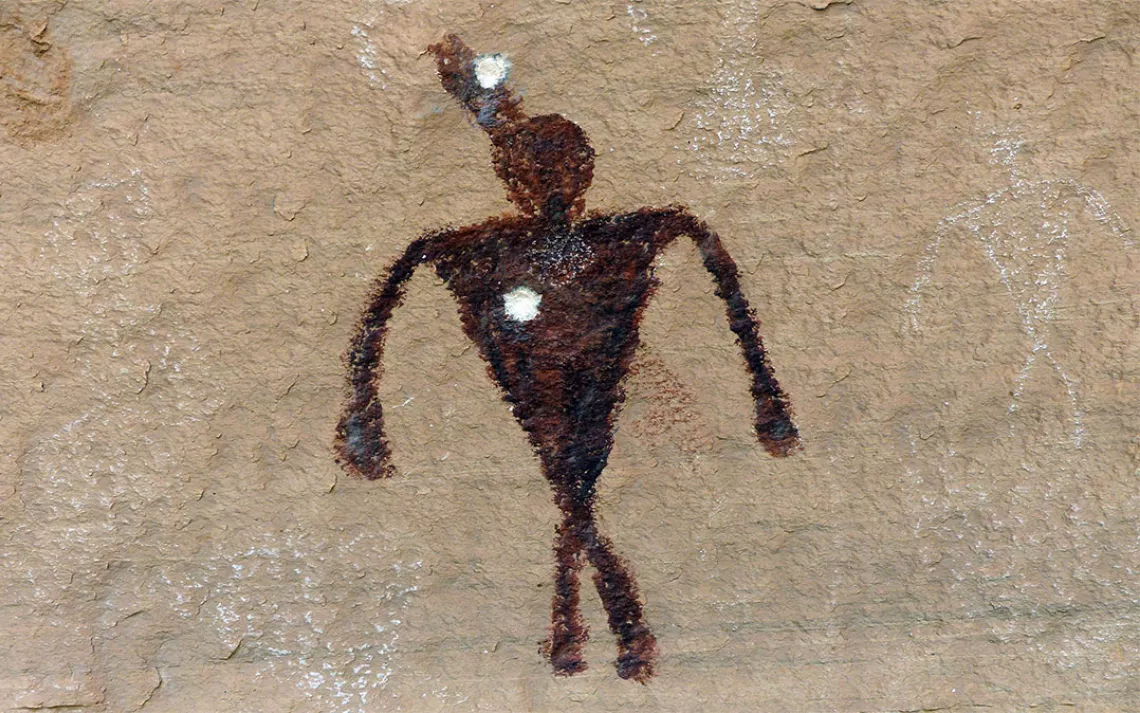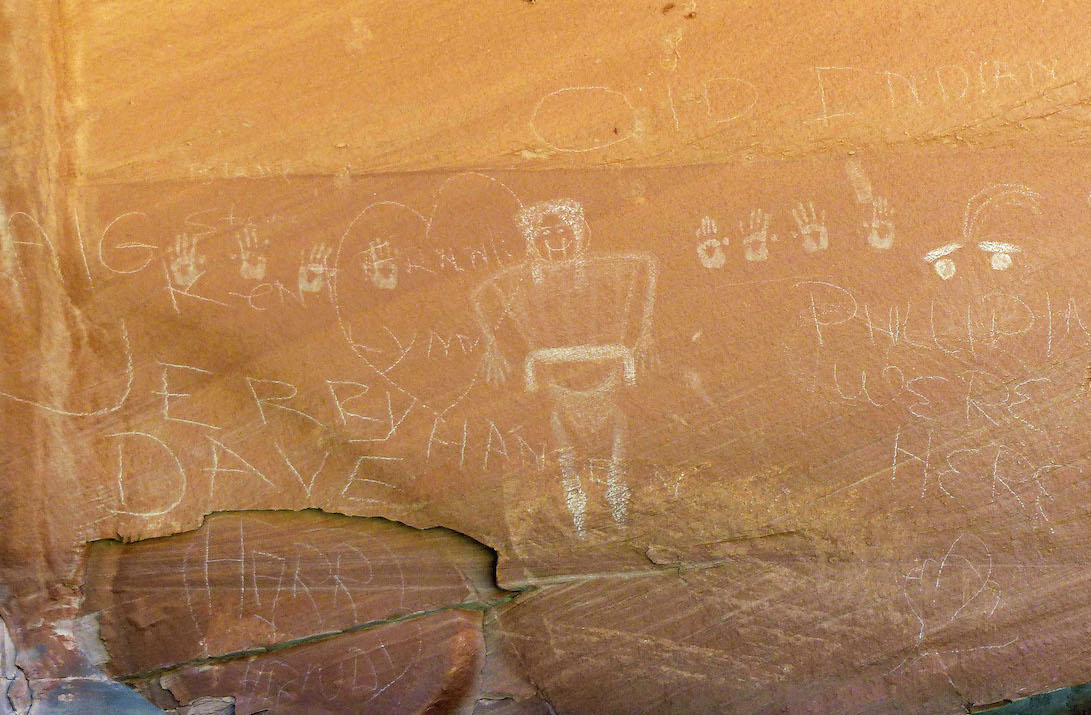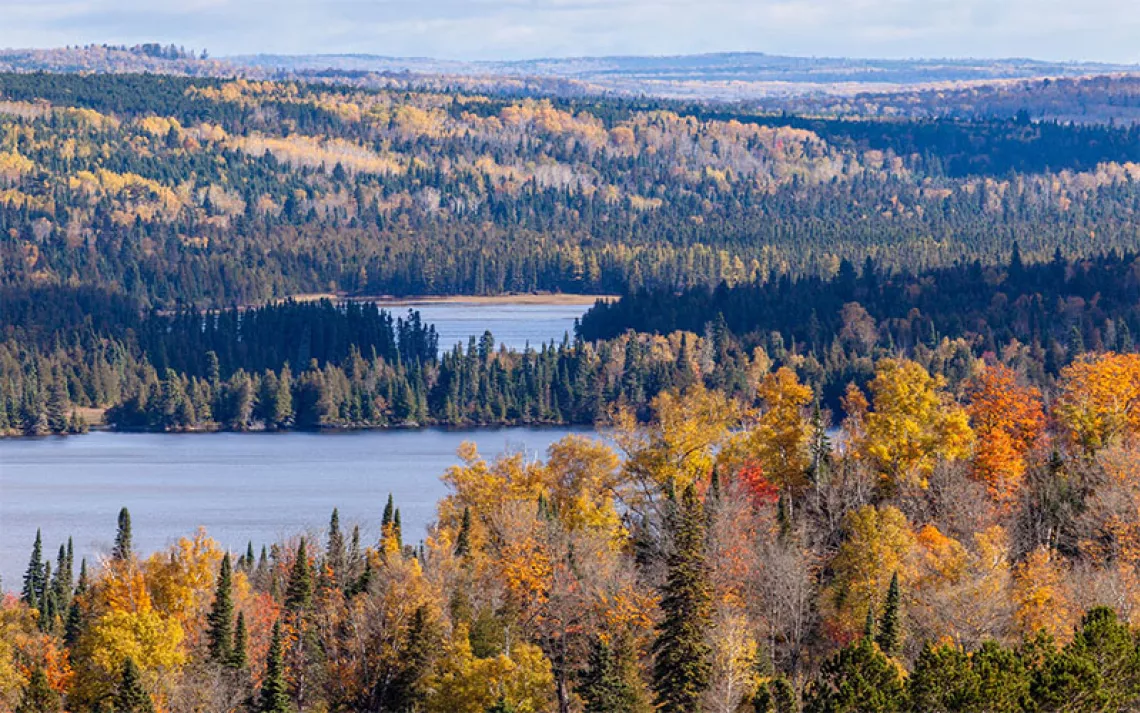A Field Day for Looters at Utah’s Unprotected Bears Ears
Volunteers try to keep ancient petroglyphs from being defaced or destroyed

Bullet scars on a Cedar Mesa pictograph
|Photos by William H. Doelle, courtesy of Archaeology Southwest
Last January, a volunteer preservationist patrolling near the town of Bluff in southeastern Utah found a rock-art panel of a humanlike figure at least five times older than the Liberty Bell but marred by a similar crack. A thief had tried to cut the petroglyph from the cliff with a rock saw, to keep or sell to a collector. The botched result was a permanently disfigured piece of Native American history—and an argument for protecting the area as part of the proposed Bears Ears National Monument.
Cedar Mesa squats near the state line and Monument Valley, bordered by the Comb Ridge monocline’s ramparts, the San Juan River’s gooseneck gorge, dendritic Grand Gulch, and forested Elk Ridge. This plateau of over 400 square miles holds more—and more varied—pre-Columbian ruins and rock art than anywhere else in the state: 25 archeology sites per square mile. The greater region boasts one of the highest concentrations of historical sites in the nation—at least 56,000 archaeological plus 100,000 cultural ones. Ancestral Puebloans, the forebears of today's Hopi and Rio Grande Pueblo people, occupied these pinyon-juniper highlands and slickrock canyons between 800 and 2,000 years ago. The area is sacred to other tribes that have roots there as well, including the San Juan Paiutes, the Utes, and the Diné (or Navajo).
As early as 1897, Richard Wetherill—a rancher in southwestern Colorado who became famous when he “discovered” Mesa Verde’s cliff dwellings—took what he had no right to take from a Grand Gulch side canyon: a mummified Ancestral Puebloan woman wrapped in quilts of turkey and canary feathers. Her body had been painted yellow, her face crimson red. Wetherill named her “The Princess,” wrapped her up again, put her in a crate, and sent her by packhorse to Durango, where she commenced a long train ride to the American Museum of Natural History in New York.
In the following decades, universities and institutions such as the Field Museum in Chicago and the Museum of Natural History in New York launched expeditions into canyon country, returning with horse-loads of relics. The excavators often also vandalized sites, cutting through rooftops or breaching walls to get to the booty.
 Vandalized portion of rock. In 1906, Theodore Roosevelt signed the Antiquities Act, which allows presidents to set aside national monuments for “the protection of objects of historic and scientific interest.” The greater Bears Ears area between Canyonlands National Park and Natural Bridges National Monument is currently being considered for such monument designation.
Vandalized portion of rock. In 1906, Theodore Roosevelt signed the Antiquities Act, which allows presidents to set aside national monuments for “the protection of objects of historic and scientific interest.” The greater Bears Ears area between Canyonlands National Park and Natural Bridges National Monument is currently being considered for such monument designation.
The era of government-sanctioned body snatching didn’t fully close until 1990. After Native American activists had asked fervently and repeatedly for the return of their pillaged dead and paraphernalia, U.S. legislators finally passed the Native American Graves Protection and Repatriation Act (NAGPRA). It now protects Native burial grounds from bulldozers and ghoulish collectors, and ordered museums to return bones, mummies, and ceremonial objects to the tribes that could claim them.
Plundering by unaffiliated individuals, however, continued unabated. There are still only two part-time rangers on Cedar Mesa, though the number of visitors doubled or even tripled over the last decade. From Basketmaker mesa-top pit houses to Pueblo fortresses perching like swallows’ nests, Grand Gulch ruins, which some people consider this region’s most outstanding, have been raided repeatedly. The looting is worst during the winter, when the Kane Gulch ranger station lies vacant. In addition to the loss of valuable artifacts sold in online black markets, looting degrades ruins and disturbs soils with clues to the past, messing up strata that allow the dating of objects. One can find rock-art panels here that split when robbers tried to saw or pry them off solid rock. The BLM, which manages Cedar Mesa, now limits visitation to some special sites and monitors them with hidden cameras.
Because of the clandestine nature of this illegal activity, the attrition is hard to quantify. But people familiar with the region have noticed drastic changes. Willie Grayeyes, chair of the board of trustees of Utah Diné Bikéyah, recounts a story told to him by a fellow Navajo who grew up not far from the twin buttes called the Bears Ears. As a child, he’d found small ceramic jars filled with arrowheads and large pottery vases brimming with different kinds of corn kernels: yellow, blue, and multihued. Pinewood ladders still leaned against canyon walls, ready for use. When he revisited the ruins after the Vietnam War, the walls had been knocked down, and the sacred treasures had vanished: Robbers had driven a truck in one night and taken everything.
Starting six years ago, Utah Diné Bikéyah formed the Bears Ears Coalition, uniting 24 tribes, rock climbers, and numerous conservation groups in a fight to protect such American heirlooms, together with the landscape that harbors them. Friends of Cedar Mesa (FCM), one of the coalition’s member organizations, mounts volunteer patrols that visit vulnerable archaeological sites and report damage or suspicious activities to the BLM. They even offer anti-looting rewards of up to $2,500 for information leading to convictions. In the first six months of 2016, FCM tracked seven major incidents in the Bears Ears area.
Besides using deterrence, the Friends educate the public through its Visit With Respect program, which works in concert with the BLM’s Respect and Protect campaign, both geared toward careless visitors who damage sites unintentionally. That, says FCM executive director Josh Ewing, “is by far the greater amount of damage, although less in-your-face compared to looting and vandalism.”
About looters, Ewing is far less optimistic: “These folks know this is against the law and do it because they can make money and have no fear of getting caught—hopefully until now.”
What You Can Do
Protect Utah’s Bears Ears: Tell President Obama to take action and designate Bears Ears as a national monument to protect these lands for the generations to come. Send a message today.
 The Magazine of The Sierra Club
The Magazine of The Sierra Club






